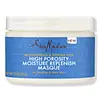What's inside
What's inside
 Benefits
Benefits

 Concerns
Concerns

 Ingredients Side-by-side
Ingredients Side-by-side

Water
Skin ConditioningCetearyl Alcohol
EmollientCetyl Alcohol
EmollientBehentrimonium Chloride
PreservativeHydrogenated Castor Oil
EmollientPropanediol
SolventStearalkonium Chloride
PreservativeHeptyl Undecylenate
EmollientCaprylic/Capric Triglyceride
MaskingHydroxypropylgluconamide
HumectantHydroxypropylammonium Gluconate
HumectantAspergillus Ferment
Skin ConditioningArginine
MaskingRice Amino Acids
Skin ConditioningPersea Gratissima Oil
Skin ConditioningMauritia Flexuosa Fruit Oil
Skin ConditioningSclerocarya Birrea Seed Oil
HumectantCetrimonium Chloride
AntimicrobialHydroxyethylcellulose
Emulsion StabilisingTetrasodium Glutamate Diacetate
Parfum
MaskingPhenoxyethanol
PreservativeEthylhexylglycerin
Skin ConditioningWater, Cetearyl Alcohol, Cetyl Alcohol, Behentrimonium Chloride, Hydrogenated Castor Oil, Propanediol, Stearalkonium Chloride, Heptyl Undecylenate, Caprylic/Capric Triglyceride, Hydroxypropylgluconamide, Hydroxypropylammonium Gluconate, Aspergillus Ferment, Arginine, Rice Amino Acids, Persea Gratissima Oil, Mauritia Flexuosa Fruit Oil, Sclerocarya Birrea Seed Oil, Cetrimonium Chloride, Hydroxyethylcellulose, Tetrasodium Glutamate Diacetate, Parfum, Phenoxyethanol, Ethylhexylglycerin
Water
Skin ConditioningCetearyl Alcohol
EmollientButyrospermum Parkii Butter
Skin ConditioningCaprylic/Capric Triglyceride
MaskingStearamidopropyl Dimethylamine
EmulsifyingBehentrimonium Chloride
PreservativeParfum
MaskingHydrogenated Vegetable Oil
EmollientSchinziophyton Rautanenii Kernel Oil
EmollientSimmondsia Chinensis Seed Oil
EmollientAloe Barbadensis Leaf Juice
Skin ConditioningAdansonia Digitata Seed Oil
EmollientPanthenol
Skin ConditioningHydroxyethylcellulose
Emulsion StabilisingSodium Chloride
MaskingPolysorbate 60
EmulsifyingDisodium Phosphate
BufferingCaprylyl Glycol
EmollientSodium Citrate
BufferingBenzoic Acid
MaskingWater, Cetearyl Alcohol, Butyrospermum Parkii Butter, Caprylic/Capric Triglyceride, Stearamidopropyl Dimethylamine, Behentrimonium Chloride, Parfum, Hydrogenated Vegetable Oil, Schinziophyton Rautanenii Kernel Oil, Simmondsia Chinensis Seed Oil, Aloe Barbadensis Leaf Juice, Adansonia Digitata Seed Oil, Panthenol, Hydroxyethylcellulose, Sodium Chloride, Polysorbate 60, Disodium Phosphate, Caprylyl Glycol, Sodium Citrate, Benzoic Acid
Ingredients Explained
These ingredients are found in both products.
Ingredients higher up in an ingredient list are typically present in a larger amount.
This ingredient is a preservative and often used for it's anti-static properties. You'll most likely see this ingredient in hair conditioners.
It does not cause irritation or sensitization in leave-on products at 1-5%.
This ingredient is an emollient, solvent, and texture enhancer. It is considered a skin-softener by helping the skin prevent moisture loss.
It helps thicken a product's formula and makes it easier to spread by dissolving clumping compounds.
Caprylic Triglyceride is made by combining glycerin with coconut oil, forming a clear liquid.
While there is an assumption Caprylic Triglyceride can clog pores due to it being derived from coconut oil, there is no research supporting this.
Learn more about Caprylic/Capric TriglycerideCetearyl alcohol is a mixture of two fatty alcohols: cetyl alcohol and stearyl alcohol. It is mainly used as an emulsifier. Emulsifiers help prevent the separation of oils and products. Due to its composition, it can also be used to thicken a product or help create foam.
Cetearyl alcohol is an emollient. Emollients help soothe and hydrate the skin by trapping moisture.
Studies show Cetearyl alcohol is non-toxic and non-irritating. The FDA allows products labeled "alcohol-free" to have fatty alcohols.
This ingredient is usually derived from plant oils such as palm, vegetable, or coconut oils. There is debate on whether this ingredient will cause acne.
Due to the fatty acid base, this ingredient may not be Malassezia folliculitis safe.
Learn more about Cetearyl AlcoholHydroxyethylcellulose is used to improve the texture of products. It is created from a chemical reaction involving ethylene oxide and alkali-cellulose. Cellulose is a sugar found in plant cell walls and help give plants structure.
This ingredient helps stabilize products by preventing ingredients from separating. It can also help thicken the texture of a product.
This ingredient can also be found in pill medicines to help our bodies digest other ingredients.
Learn more about HydroxyethylcelluloseParfum is a catch-all term for an ingredient or more that is used to give a scent to products.
Also called "fragrance", this ingredient can be a blend of hundreds of chemicals or plant oils. This means every product with "fragrance" or "parfum" in the ingredients list is a different mixture.
For instance, Habanolide is a proprietary trade name for a specific aroma chemical. When used as a fragrance ingredient in cosmetics, most aroma chemicals fall under the broad labeling category of “FRAGRANCE” or “PARFUM” according to EU and US regulations.
The term 'parfum' or 'fragrance' is not regulated in many countries. In many cases, it is up to the brand to define this term.
For instance, many brands choose to label themselves as "fragrance-free" because they are not using synthetic fragrances. However, their products may still contain ingredients such as essential oils that are considered a fragrance by INCI standards.
One example is Calendula flower extract. Calendula is an essential oil that still imparts a scent or 'fragrance'.
Depending on the blend, the ingredients in the mixture can cause allergies and sensitivities on the skin. Some ingredients that are known EU allergens include linalool and citronellol.
Parfum can also be used to mask or cover an unpleasant scent.
The bottom line is: not all fragrances/parfum/ingredients are created equally. If you are worried about fragrances, we recommend taking a closer look at an ingredient. And of course, we always recommend speaking with a professional.
Learn more about ParfumWater. It's the most common cosmetic ingredient of all. You'll usually see it at the top of ingredient lists, meaning that it makes up the largest part of the product.
So why is it so popular? Water most often acts as a solvent - this means that it helps dissolve other ingredients into the formulation.
You'll also recognize water as that liquid we all need to stay alive. If you see this, drink a glass of water. Stay hydrated!
Learn more about Water